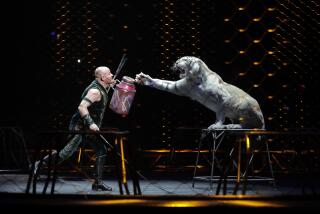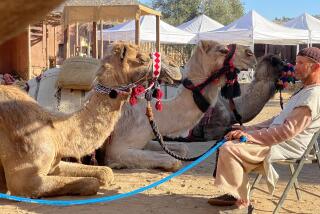Outback Ranchers Look to Cash In on Last Herd of Wild Camels
- Share via
ALICE SPRINGS, Australia — Standing more than 8 feet high and weighing the best part of a ton, Tinkerbell the camel isn’t happy. She kicks up red dust and groans as veterinarians try to give her a shot to heighten her reproductive abilities.
Tinkerbell, Duchess and Kaman are in a scientific program testing camel DNA and investigating artificial insemination techniques that could eventually lead to more births.
“We are trying to make them super-ovulate,” veterinarian Greg Crawford says while trying to soothe Tinkerbell so a colleague, Joffrid Mackett, can give the injection. “They have had these shots a couple of times now, and they know what’s coming. They’re not real keen for it to happen again.”
The program is part of an effort to find business uses for the world’s last wild herd of camels--in the Australian outback. Camels are now all domesticated in the Middle East and North Africa.
Introduced to Australia as a pack animal in the mid-1800s, the durable one-humped camel, or Camelus dromedarius, has made a huge area of the country’s interior its own and now exists happily alongside kangaroos, emus and dingoes.
For more than 60 years, camels were used instead of horses in Australia’s arid and desolate interior, where temperatures can rise above 120 degrees during the day and drop below freezing at night. They helped explorers search for gold, settlers carry building materials and supplies, and policemen patrol remote areas.
An inland transport network was dependent on camels and the drivers who tended them, mainly people from the Northwest Frontier of British India.
By the 1920s, motorized vehicles had caught up with the camel, and an estimated 12,000 were shot or turned loose. Those that survived flourished.
Camel numbers are now estimated at 200,000, and they range over an area of more than 1 million square miles in five states.
The island continent has provided a natural quarantine and prevented tuberculosis, brucellosis and other infectious diseases from taking hold.
“They are genetically clean and disease-free,” said Peter Seidel, chairman of the Central Australian Camel Industry Assn.
That is one of the advantages the association hopes to use to turn Australia’s fledgling camel industry into an export business. The group has its eye on meat for Southeast Asia, parts for folk medicines in China and possibly racing camels for the Middle East.
*
The first problem is catching a wild camel.
“We go out with a plane. We spot them, then we run them back into the yard with a [trail] bike,” said Francis “Boof” Smith, who manages the 3,000-square-mile Newcrown ranch 160 miles southwest of Alice Springs.
“It sounds easy until you go out and do it. If you’re not in the right place at the right time, you don’t get any in the yard, I tell you that.”
Smith is one of about 10 ranchers who are trying to supplement their cattle operations with camels, supplying about 300 camels a year from the wild to a small but growing domestic meat market. They also supply animals for live export, mostly to the United States for tourist safari-type operations, but also to Asia and the Middle East.
The United Arab Emirates, where camel racing is big business, is particularly interested in Australian animals, which could offer new blood to a tired gene pool. But bungling attempts by overeager Australian ranchers to sell the “million-dollar camel” have made potential buyers cautious, Seidel said.
Few of the sleek, fine-boned Sudanese camels used in the long-distance races in the Middle East were introduced to Australia, and they are hard to find. So when Australian draft camels were flown to the Emirates and tested over long-distance tracks, many did not last.
“Most of them died on the spot,” Seidel said. “At the moment, we don’t have a great reputation for racing in the Middle East.”
Results of the DNA program are likely to be years away. In the meantime, Seidel said, meat exports--and spinoffs like leather and camel parts eaten as delicacies and used in Chinese medicine--are the future for the industry.
“The meat industry provides us with more value per animal than other uses,” he said. Including byproducts, a good-sized carcass can be worth about $3,500.
Seidel said Southeast Asia, where consumers are expected to be less reticent about eating camel meat than they are in Australia, is potentially worth millions.
Problems include ensuring supply. Meatpackers and unions have proved reluctant to commit to working on camel carcasses, which are bigger than cows.
“If we can get it off the ground, it could become a really good second industry for us,” he said. “But until we get an abattoir where we can kill most of what you get in the yard, it’s going to be uneconomical.”
More to Read
Sign up for Essential California
The most important California stories and recommendations in your inbox every morning.
You may occasionally receive promotional content from the Los Angeles Times.













